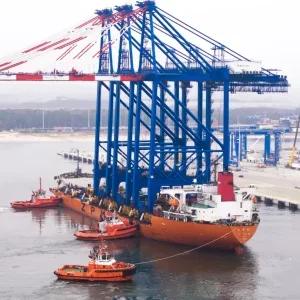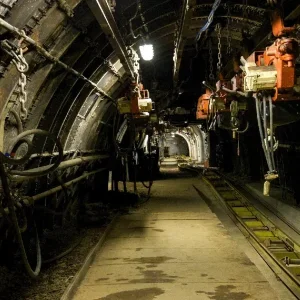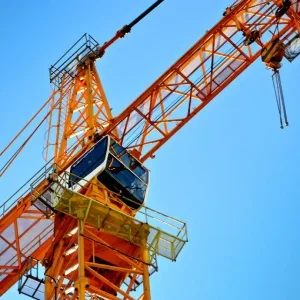Harris Walton Lifting Gear is the only remaining UK manufacturer of British Standard eye bolts, says managing director Terry John. It is based in the Black Country, that region of the Midlands historically famous for heavy metal bashing industries. “Three or four years ago we had two robots working six days a week, 22 hours a day, unmanned. We used to do [production] runs of 100,000,” he says.

Millbank Group produces concrete flooring units in Weeting, Norfolk, and to cope with increasing demand has installed two new cranes from Street inside the factory and an additional one in its yard
Today, all the standard sized eyebolts in Britain are shipped in by the container load from China. “Now we only do specials that people can’t get from China,” John says.
Harris Walton survives because it already has the tools and dyes that would be uneconomic to forge for short production runs.
Terry John fears for the future. He has seen imported eyebolts come in from China with Harris Walton’s own unique identity code on them. Original Harris Walton eyebolts are sent to China by UK importers to be copied, he says, and come back so faithfully reproduced that “they haven’t even the sense to remove our unique numbers.”
He also tells of importers seeking to repair faulty welds on Chinese-made eyebolts. “You can’t repair a weld on an eyebolt because you can’t heat treat it after it’s been threaded. It will burn the thread off. But it’s going on,” he says.
Special orders, not demanded in large enough numbers to fill a Chinese container, keep the company ticking over, he says. The offshore industry, in particular, tends to use 8UN eyebolts – eight threads per inch, UN form. Special threads are also produced for construction contractors to use in pre-stressed concrete.
Asked what the future holds for his business, John replies: “Not good really. We’re just hanging on. A lot of the people here have been here 20, 30 or 40 years. We are working just to keep the factory open for the people who are employed here.”
However, while the experience of Harris Walton is shared by many companies, not just in the UK but throughout the early industrialised nations of the world, British manufacturing in fact remains in good health, according to the Confederation of British Industry (CBI), the business leader’s trade association.
Andrew Reynolds Smith, chairman or the CBI’s Manufacturing Council and executive director of automotive engineering company GKN, said recently: “Manufacturing is misunderstood. Public opinion is of a small, declining sector, owned by foreigners and on the brink of being totally offshored to China. But in fact there are over 150,000 businesses that manufacture in the UK, turning over £500bn ($1,000bn). Last year they accounted for 60% of UK exports, worth £220bn – which is an increase on the previous year.” He added that 21 of the largest 100 publicly quoted companies are in manufacturing.

Street Crane recently installed two special 10t double girder cranes for the Worksop plant of Wedge Galvanizing, which operates the longest galvanizing bath in Europe. The new cranes are used in the pre-treatment bay for sequential de-greasing, rinsing and fluxing of both components and large structures prior to hot-dip galvanizing
So while old fashioned manufacturing industries involving heating, moulding or bashing lumps of metal to craft them into something useful may be dead or dying, there remains a massive and healthy customer base for companies in the industrial lifting sector, most of which can now be characterised as service companies just as much as manufacturers.
A company like Crane Services of the West Midlands, for example, builds overhead cranes but is also a distributor for Demag and Morris. Active customer industries include aerospace, steel and aluminium extrusion, says managing director Rob Lewis, and sales this year are up 10% on last year. Growth comes from the development of more sophisticated crane and hoist control systems, he says, such as inverter drives and radio control, as well as from growing demand for semi and fully automated systems.
SCM Materials Handling, based in Taunton, also has a healthy workload at the moment, says sales manager Alan Watkins. “It’s evolved from hoists and things like that to fully integrated automated systems,” he says. Watkins says that busy areas include the manufacture of handling equipment for a large press manufacturer, for loading their presses, and supplying the aerospace industry.
“I think UK manufacturing has gone through a very difficult patch, with imports form the Far East,” Watkins says, but he firmly believes that the quality of UK manufacturing will sustain it. “As price differentials equalise, as they will, British industry will survive because of quality,” he says.
Another development in UK industry, again common to many countries throughout the world, and a result of globalisation, is the growth of huge distribution centres. Not only are these facilities used to break bulk from containers but also to service the growth of e-commerce. An online retailer like Amazon maintains huge stock and distributes directly from “warehouse” to the consumer’s front door in single unit quantities. Such changes in logistics drives a change in materials handling needs. Thus SCM, for example, has recently opened a new division specialising in pallet wrapping.
Bill Oliver, sales and technical director of Morris Material Handling, recognises the difficulties facing British industry, but also sees plenty of opportunity. “There are understandably many mixed views about the health of manufacturing here in the UK,” he says, “and it goes without saying that certain sectors have faced and will continue to face a difficult future, the foundry trade being a very good example. That said, many sectors are performing well and will continue to do so in the future. For companies such as Morris, the challenge is to continue to identify the buoyant market areas and meet the needs of those companies that continue to take the lead in their own specific field.”
He continues: “In recent months the equipment side of the business has seen a hesitancy from some small equipment buyers, probably fuelled by recent interest rate rises. However the larger projects are still progressing well, which is currently more than compensating for the hesitancy at the smaller end of the market.”
The number of larger projects going ahead has enabled Morris, now part of Konecranes, to achieve “consistent growth across all aspects of the business over the last few years,” Oliver says. “The crane business in particular is growing very strongly and is currently forecast to be in excess of 20% up on last year. This will also be complimented by the Maintenance Services Division of the company that once again expects to achieve strong double digit growth when compared to that of the previous year.”
He adds: “One of the key areas where Morris is experiencing consistent growth is from industries within what we term as one of our key strategic market areas of general manufacturing. More specifically though, we are also experiencing much success within the areas of transportation, and in particular the rail and steel warehousing sectors. Furthermore, we anticipate a marked growth in the power generation sector over the next year. This will be primarily driven by a number of new power stations that are scheduled to be built.”
Oliver explains that the Morris strategy is to concentrate on customer service. “One of the main drivers that we believe is serving to move the Morris business forward so strongly is our continued focus on delivering high levels of customer service,” he says. “Not only is this key in ensuring that we retain any new customers, it is proven that such an approach proves to be instrumental in securing more business from our existing customer base through true working partnerships.”
He also says that opportunities are growing as crane owners continue to outsource maintenance work. “An increasing number of customers, both new and existing, are waking up to the benefits that can be gained from applying an effective inspection and maintenance programme to their lifting equipment. In fact more and more companies are beginning to realise the importance of keeping what are their key assets in effective and efficient working order,” Oliver says.
Suppliers to car manufacturers and waste water treatment works are keeping Granada Materials Handling particularly busy with crane building, says sales director Mark Sidwell, although food processing, pharmaceuticals and aerospace industries are also active. “The service side is also pretty buoyant. Customers are going for upgrades and modernizing as a cheaper alternative to replacement,” he says.
Sidwell thinks that crane companies that can offer a bespoke solution, rather than just rely on off-the-shelf products should not be lacking work at the moment. “That work is definitely out there,” he says.
Other industrial sectors are in excellent health, including construction and energy, providing a lot of work for suppliers of lifting equipment and services. IMES Group, for example, which supplies water bags for load testing, says it is benefiting from the health of the oil and gas industry.
Lift Turn Move, established just three years ago, is seeing all its hopes for growth come to reality thanks to a booming construction industry. Operations director Dave King says that 2007 sales are already 40% up on 2006 and still rising.
King says: “We have expanded our product offering further in 2007 and recruited key staff who we know can grow our business from strength to strength. We are always looking at ways to improve our service to clients – our philosophy is to make it as simple as possible for the purchaser to buy – and by doing this we hope sales will continue to grow.”
Asked which client sectors he expects to drive future growth, King responds: “Construction mainly, due to the massive infrastructure projects currently taking place in the UK. We are also targeting the water industry with specially selected products sourced from around Europe”. These include stainless steel jib cranes and wire rope pulleys.
Giving hope to companies like Harris Walton that are reeling from the effect of low cost Chinese imports, King continues: “We are noticing a distinct separation of clients who buy on price and price only, to those who are prepared to listen to arguments why a particular product is better for their requirements. Price is always key to any product offering, but we think too many people have had their fingers burnt buying on price and price alone, so they are seeking preferred partners for their lifting equipment who have the knowledge to back up the sale for years to come.”
King is upbeat about the future of the lifting industry. “The markets we serve are constantly evolving,” he says. “There are more and more solutions to the same application. To survive as a company we are constantly looking for new ways of solving existing problems but also looking at ways to solve new problems with existing machinery. This is how we can help our clients, by using our experience to help them.”
He concludes: “Some people may say there is less manufacturing in the UK so the requirement for lifting equipment has gone down. But you only have to look at the amount of distribution facilities there are now – and all of these require lifting equipment in some form – to appreciate that there are still plenty of opportunities to be sought out. It is about remaining positive, even when things do not feel that way.”
Street Crane is also in a positive mood. “The UK market is currently very buoyant with sales up around 14% this year compared to last,” says sales director Gus Zona. “Sectors that seem to be particularly keen to invest include construction – partly driven by the move to off-site techniques, power generation and leisure. We have just completed a further phase of work for Princess Yachts and have work in hand for Fairline Boats.
“Looking to 2008 we expect the upward trend to continue. This will be led by expansion in metals. The aluminium industry continues to build new capacity with year by year investment. After a pause in recent years in investment from the steel and heavy engineering sector, we are also seeing increasing interest from steel producers, distributors and galvanisers in more sophisticated and higher specification cranes.”
Asked what conclusions he can draw about the state of UK manufacturing, based on Street’s experience, Zona says: “The answer has to be positive – manufacturers in many sectors seem to be showing greater confidence and investing in new capacity with better specification cranes to help them achieve higher performance.”
Derrick Bailes is chief executive of the UK-based Lifting Equipment Engineers Association (LEEA). He says there has been no decline in member companies as a result of deteriorating market conditions. Quite the reverse – numbers continue to rise. The market seems “quite healthy at the moment, although I wouldn’t say it was growing,” he says. “It still going through the process of adjusting itself to the new situation of a lot of manufacturing being based in the Far East.”
Bailes says that the LEEA members that seem to be doing best are those that either have some sort of niche market or those that add value in the UK to components imported from China under a rigorous quality control regime.
There is not much room in the market today, however, for distribution companies who simply buy UK or European made lifting equipment and re-sell it. Non-specialists have entered the market, mail-order or internet sources, adding lifting tackle to their general catalogues of tools or gardening equipment. Specialists must find new ways to add value to stay in the game.
Millbank Group produces concrete flooring units in Weeting, Norfolk, and to cope with increasing demand has installed two new cranes from Street inside the factory and an additional one in its yard UK 2 Street Crane recently installed two special 10t double girder cranes for the Worksop plant of Wedge Galvanizing, which operates the longest galvanizing bath in Europe. The new cranes are used in the pre-treatment bay for sequential de-greasing, rinsing aUK 3 Crane builders and lifting equipment suppliers are benefiting from the construction boom, not in supplying contractors directly but also in supplying companies all through the supply chain UK 1 Lift Turn Move is targeting the water industry with special lifting products such as this stainless steel wire rope pulley UK 6 Lift Turn Move is targeting the water industry with special lifting products such as this stainless steel jib crane UK 4 Crane Services of the West Midlands has experienced growth due to demand for more sophisticated control systems. This Flex 8EX radio control was installed for boat builder Sunseeker in Poole, Dorset UK 5 Derrick Bailes is chief executive of the UK-based Lifting Equipment Engineers Association (LEEA). He says there has been no decline in member companies as a result of deteriorating market conditions. Quite the reverse – numbers continue to rise Derrick Bailes






